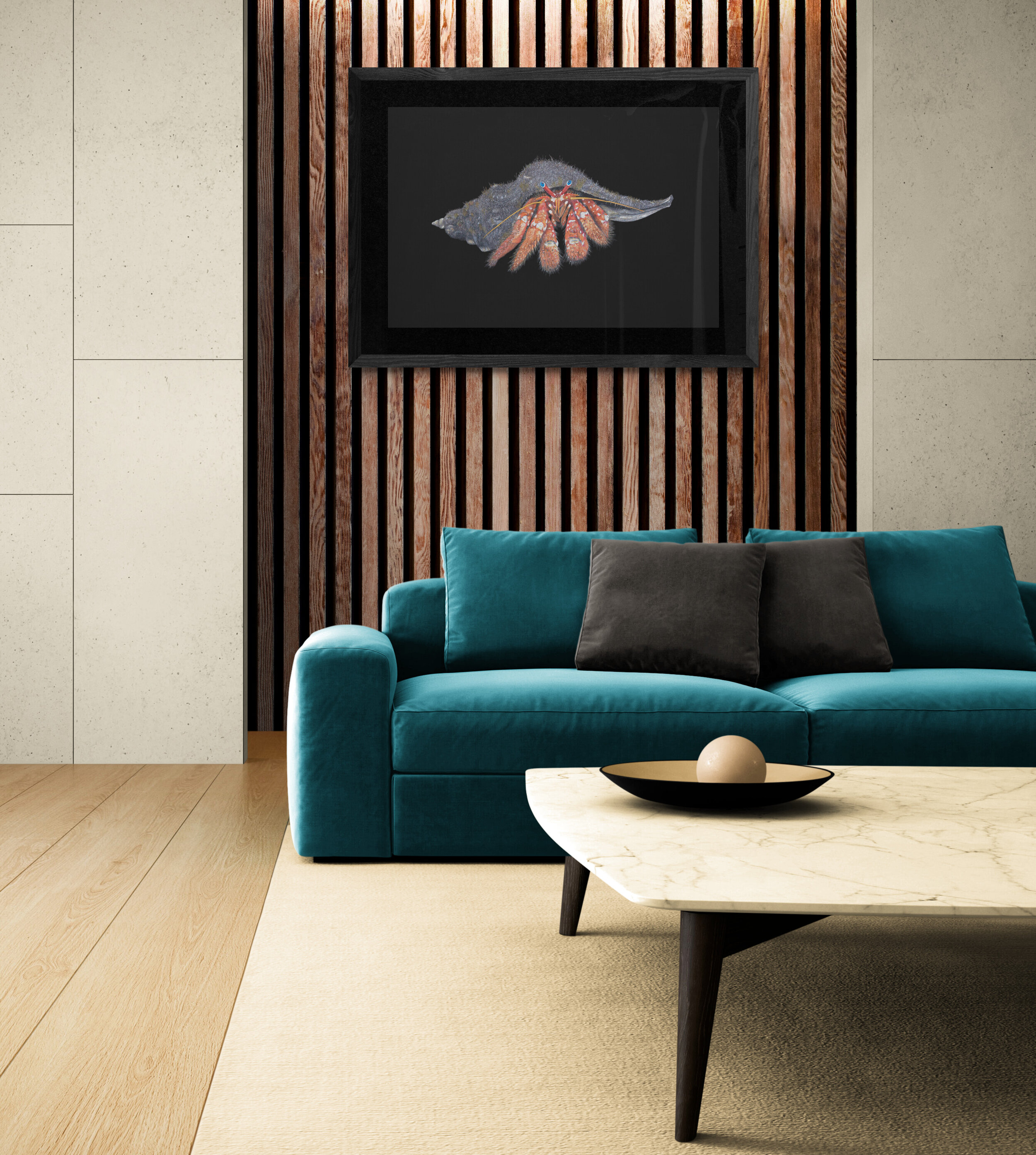Rasping Hermit Crab - Open Edition Prints
"Rasping Hermit Crab" is an intimate portrayal of the resilient and adaptable rasping hermit crab, rendered in vibrant colour pencil on black paper. This drawing, inspired by an image captured in the murky waters of the River Derwent, Tasmania, highlights the crab's unique features and its ability to thrive in less-than-ideal conditions.
In this piece, the hermit crab is depicted with meticulous detail, showcasing its intricate shell, textured claws, and the subtle interplay of colours that bring it to life. The contrast of the crab’s vibrant hues against the deep black background emphasises its form and the rugged beauty of its chosen environment. The murkiness of the water is suggested by the overall dark tone, adding depth and context to the crab’s habitat.
This print has been created from an original colour pencil drawing on black cotton rag paper (2021). The original image of the hermit crab was captured by Tasha Waller at Battery Point in the Derwent Estuary, Tasmania.
Prints are produced locally using the highest quality cotton rag paper with archival pigment inks with a fade resistant life of up to and exceeding 100 years.
The surface of the printed cotton rag paper is delicate and needs to be handled with care. It is recommended the prints are delivered to a professional framer. To avoid reflections from the glass, it is highly recommended AR70 non-reflective glass is used.
Prints are printed on demand, please allow 10-15 days for prints to arrive within Australia. A4 and A3 prints will be posted flat in a rigid mailer, A2 prints will be rolled into a mail tube.
Free postage within Australia, international postage will be calculated at the checkout.
"Rasping Hermit Crab" is an intimate portrayal of the resilient and adaptable rasping hermit crab, rendered in vibrant colour pencil on black paper. This drawing, inspired by an image captured in the murky waters of the River Derwent, Tasmania, highlights the crab's unique features and its ability to thrive in less-than-ideal conditions.
In this piece, the hermit crab is depicted with meticulous detail, showcasing its intricate shell, textured claws, and the subtle interplay of colours that bring it to life. The contrast of the crab’s vibrant hues against the deep black background emphasises its form and the rugged beauty of its chosen environment. The murkiness of the water is suggested by the overall dark tone, adding depth and context to the crab’s habitat.
This print has been created from an original colour pencil drawing on black cotton rag paper (2021). The original image of the hermit crab was captured by Tasha Waller at Battery Point in the Derwent Estuary, Tasmania.
Prints are produced locally using the highest quality cotton rag paper with archival pigment inks with a fade resistant life of up to and exceeding 100 years.
The surface of the printed cotton rag paper is delicate and needs to be handled with care. It is recommended the prints are delivered to a professional framer. To avoid reflections from the glass, it is highly recommended AR70 non-reflective glass is used.
Prints are printed on demand, please allow 10-15 days for prints to arrive within Australia. A4 and A3 prints will be posted flat in a rigid mailer, A2 prints will be rolled into a mail tube.
Free postage within Australia, international postage will be calculated at the checkout.
"Rasping Hermit Crab" is an intimate portrayal of the resilient and adaptable rasping hermit crab, rendered in vibrant colour pencil on black paper. This drawing, inspired by an image captured in the murky waters of the River Derwent, Tasmania, highlights the crab's unique features and its ability to thrive in less-than-ideal conditions.
In this piece, the hermit crab is depicted with meticulous detail, showcasing its intricate shell, textured claws, and the subtle interplay of colours that bring it to life. The contrast of the crab’s vibrant hues against the deep black background emphasises its form and the rugged beauty of its chosen environment. The murkiness of the water is suggested by the overall dark tone, adding depth and context to the crab’s habitat.
This print has been created from an original colour pencil drawing on black cotton rag paper (2021). The original image of the hermit crab was captured by Tasha Waller at Battery Point in the Derwent Estuary, Tasmania.
Prints are produced locally using the highest quality cotton rag paper with archival pigment inks with a fade resistant life of up to and exceeding 100 years.
The surface of the printed cotton rag paper is delicate and needs to be handled with care. It is recommended the prints are delivered to a professional framer. To avoid reflections from the glass, it is highly recommended AR70 non-reflective glass is used.
Prints are printed on demand, please allow 10-15 days for prints to arrive within Australia. A4 and A3 prints will be posted flat in a rigid mailer, A2 prints will be rolled into a mail tube.
Free postage within Australia, international postage will be calculated at the checkout.



